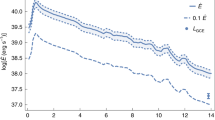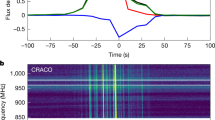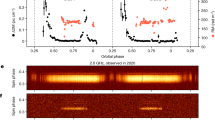Abstract
THE birth-rate of radio pulsars in globular clusters (GCs) is thought to be a factor of 10 to 100 times greater than that of their candidate progenitors, low-mass X-ray binaries (LMXBs) of canonical lifetime 108 to 109 yr. This apparent discrepancy1,2 would be removed either if there were more rapid accretion of mass onto the primary in the late stages of LMXB evolution (as suggested by the self-excited wind model3), or if there occurred accretion-induced collapse of white dwarfs in binaries with wide orbits4,5. But the available data (Table 1) indicate that GC pulsars cannot be formed by either of these mechanisms alone. Here we suggest that both processes may be necessary to some extent, the corollary of which is that GC pulsars may have at least two distinct classes of progenitors. Many solitary and binary pulsars with short orbital periods may have descended from rapidly evolving LMXBs, whereas others, especially those with long periods, may have formed from binaries that undergo nuclear evolution of the secondary and eventual accretion-induced collapse of the white-dwarf primary.
This is a preview of subscription content, access via your institution
Access options
Subscribe to this journal
Receive 51 print issues and online access
$199.00 per year
only $3.90 per issue
Buy this article
- Purchase on SpringerLink
- Instant access to full article PDF
Prices may be subject to local taxes which are calculated during checkout
Similar content being viewed by others
References
Romani, R. in Supernovae and Stellar Evolution (eds Ray, A. & Velusamy, T.) (World Scientific, Singapore, in the press).
Kulkarni, S. R., Narayan, R. & Romani, R. Astrophys. J. (in the press).
Ruderman, M., Shaham, J., Tavani, M. & Eichler, D. Astrophys. J. 343, 292–312 (1989).
Grindlay, J. E. & Bailyn, C. D. Nature 336, 48–50 (1988).
Bailyn, C. D. & Grindiay, J. E. Astrophys. J. (in the press).
Taam, R. Astrophys. J. 270, 694–699 (1983).
Webbink, R., Rappaport, S. & Savonije, G. Astrophys. J. 270, 678–693 (1983).
Fruchter, A. S. & Goss, W. M. Bull. Am. Astr. Soc. 21, 1204 (1989).
Kulkarni, S. R. & Narayan, R. Astrophys. J. 335, 755–768 (1988).
Kluźniak, W., Ruderman, M., Shaham, J. & Tavani, M. Nature 334, 225–227 (1988).
Tavani, M., Ruderman, M. A. & Shaham, J. Astrophys. J. 342, L31–L34 (1989).
Clark, G. W. Astrophys. J. 199, L143–L145 (1975).
Fabian, A. C., Pringle, J. E. & Rees, M. J. Mon. Not. R. astr. Soc. 172, 15p–18p (1975).
Ray, A., Kembhavi, A. K. & Antia, H. M. Astr. Astrophys. 184, 164–172 (1987).
Spitzer, L. Dynamical Evolution of Globular Clusters (Princeton University Press, 1987).
Djorgovski, S. G. & King, I. R. Astrophys. J. 305, L61–L65 (1986).
Verbunt, F. & Hut, P. in IAU Symp. No. 125, The Origin and Evolution of Neutron Stars (eds Helfand, D. & Huang, J.) 187–197 (Reidel, Dordrecht, 1987).
Verbunt, F. & Meylan, G. Astr. Astrophys. 203, 297–305 (1988).
Ruderman, M. A. & Sutherland, P. G. Astrophys. J. 196, 51–72 (1975).
Chanmugam, G. & Brecher, K. Nature 329, 696–698 (1987).
Alpar, M. A., Cheng, A. F., Ruderman, M. A. & Shaham, J. Nature 300, 728–730 (1982).
Ruderman, M., Shaham, J. & Tavani, M. Astrophys. J. 336, 507–518 (1989).
Ray, A. & Kembhavi, A. K. Mod. Phys. Lett. A3, 229–235 (1988).
Rappaport, S., Putney, A. & Verbunt, F. Astrophys. J. (in the press).
Nomoto, K. in 13th Texas Symp. on Relativistic Astrophysics (ed. Ulmer, M. P. 519–528 (World Scientific, Singapore, 1989).
van den Heuvel, E. P. J. J. Astrophys. Astr. 5, 209–233 (1984).
Lyne, A. G. et al. Nature 328, 399–401 (1987).
Wolszczan, A. et al. IAU Circ. No. 4880 (1989).
Anderson, S. et al. IAU Circ. No. 4819 (1989).
Manchester, R. N. et al. IAU Circ. No. 4892 (1989).
Anderson, S. et al. IAU Circ. No. 4772 (1989).
Anderson, S. B., Kulkarni, S. R., Prince, T. A. & Wolszczan, A. Bull. Am. Astr. Soc. 21, 1204 (1989).
Abies, J. G. et al. Nature 342, 158–161 (1989).
Lyne, A. Nature 342, 128–129 (1989).
Ables, J. G. et al. IAU Circ. No. 4602 (1988).
Manchester, R. N. et al. IAU Circ. No. 4905 (1989).
Anderson, S. et al. IAU Circ. No. 4762 (1989).
Wolszczan, A. et al. Nature 337, 531–533 (1989).
Lyne, A. G. et al. Nature 332, 45–47 (1988).
McKenna, J. & Lyne, A. G. Nature 336, 226–227 (1988).
Anderson, S. et al. IAU Circ. No. 4853 (1989).
Lyne, A. et al. IAU Circ. No. 4974 (1990).
Author information
Authors and Affiliations
Rights and permissions
About this article
Cite this article
Ray, A., KluŹniak, W. Genesis of pulsars in globular clusters. Nature 344, 415–417 (1990). https://doi.org/10.1038/344415a0
Received:
Accepted:
Issue date:
DOI: https://doi.org/10.1038/344415a0



